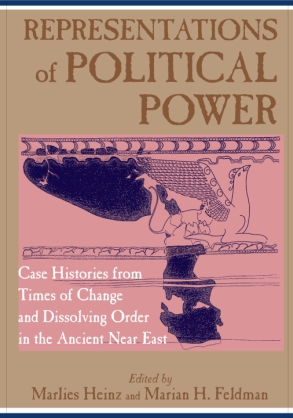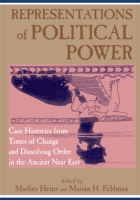
Representations of Political Power
Case Histories from Times of Change and Dissolving Order in the Ancient Near East
Edited by Marlies Heinz and Marian H. Feldman
Representations of Political Power
Case Histories from Times of Change and Dissolving Order in the Ancient Near East
Edited by Marlies Heinz and Marian H. Feldman
Representation of political power seems to have been necessary at all times in all complex urban societies. To secure order—to construct a certain social, ideological, religious, economic, and cultural stability—seems to be one of the main intentions of representation. When order breaks down or is threatened, political power comes under threat and the cohesion of the community is also in jeopardy. In times of impending change, crisis, or disorder, special effort is required to reassure the community of the rulers ability to maintain stability. What those in power did to convince the affected communities of their qualities as rulers, that is, their representational strategies — especially in times of change — is the subject of this book, explored through examination of case studies drawn from the ancient Near East. The volume is divided into three thematic parts: “Reestablishment of Order after Major Disruption,” “Changing Order from Within,” and “Perceptions of a New Order.”
- Description
- Table of Contents
Introduction: Representation–Tradition–Religion
Marlies Heinz and Marian H. Feldman
Part I: Reestablishment of Order after Major Disruption
Emar and the Transition from Hurrian to Hittite Power Regine Pruzsinszky
Frescoes, Exotica, and the Reinvention of the Northern Levantine Kingdoms during the Second Millennium B.C.E. Marian H. Feldman
Sargon of Akkad: Rebel and Usurper in Kish Marlies Heinz
Part II: Changing Order from Within
The Royal Cemetery of Ur: Ritual, Tradition, and the Creation of Subjects Susan Pollock
The Divine Image of the King: Religious Representation of Political Power in the Hittite Empire Dominik Bonatz
Nabonidus the Mad King: A Reconsideration of His Steles from Harran and Babylon Paul-Alain Beaulieu
Part III: Perceptions of a New Order
Cyrus the Great of Persia: Images and Realities Amelie Kuhrt
The Migration and Sedentarization of the Amorites from the Point of View of the Settled Babylonian Population Brit Jahn
Mailing List
Subscribe to our mailing list and be notified about new titles, journals and catalogs.



